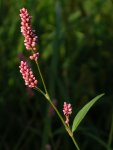Highlander pochechuyny (pochechuynaya grass) - polygonum persicaria l.
Buckwheat family - Polygonaceae
Botanical characteristics. The family is buckwheat. Annual herbaceous plant, stem straight, up to 50 cm high, knotty, furrowed. Leaves alternate, short-petiolate, linear-lanceolate with dark red or black spots. White-pink flowers are collected at the ends of the stems in short and thick spiky brushes. Blossoms in June-September. Fruit - a black nutlet egg-shaped.
Spread. It is widely distributed throughout Russia, except the Far North and deserts. Favorite habitats are rivers and lakes, raw meadows, gardens and orchards.
Used parts of the plant.
All the grass collected during flowering.
In the aerial part of the plant, tannins, gallic acid, flobafenes, flavonoids, essential oils have been found.
Application.
It is based on the expressed hemostatic action of the herb. In folk medicine, a mountainous pochechuin is used in the treatment of hemorrhoids, as well as in uterine and gastrointestinal hemorrhages. The grass has a mild laxative and diuretic effect. It is sometimes used for enterocolitis accompanied by spastic or atonic constipation.
As an external agent is prescribed for skin eczema and with long-healing ulcers.
Contraindications. Pregnancy.
Preparation. 1 tablespoon is insisted on 0.5 liters of boiling water - a daily dose.




Comments
When commenting on, remember that the content and tone of your message can hurt the feelings of real people, show respect and tolerance to your interlocutors even if you do not share their opinion, your behavior in the conditions of freedom of expression and anonymity provided by the Internet, changes Not only virtual, but also the real world. All comments are hidden from the index, spam is controlled.